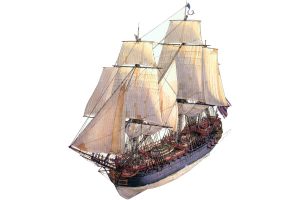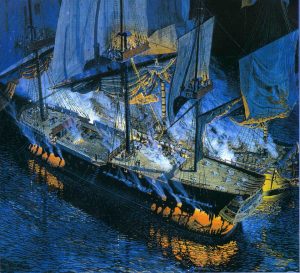For five weeks a young Scottish-born captain in the new Continental Navy had been sailing around the British Isles, raiding towns and cities, capturing or sinking many valuable merchant ships, and generally raising alarm and havoc under the nose of the greatest naval power on earth.
All that changed on September 23, 1779, when forty one sail were sighted off Flamborough Head, on the north-east coast of England. Captain John Paul Jones knew he had found the great Baltic convoy, the very lifeblood of England’s naval dockyards. Jones ordered his small squadron to attack and prepared for action.
Between Jones and the convoy lay the Royal Navy escorts, the 44-gun ship Serapis, and the 20-gun ship Countess of Scarborough. Serapis was a 44-gun brand-new two-decker with frigate lines, commanded by a seasoned captain and crew. Jones’s ship, the Bonhomme Richard, was a weary fourteen-year-old East Indiaman converted into a 40-gun ship and lent to the Continental Navy by King Louis XVI of France.
Though Jones was flying the British ensign and wearing an English-style uniform, his adversary, Captain Richard Pearson, R.N., was highly suspicious that this was “Paul Jones the Pirate” and prepared for action.
Within musket shot range (80 yards) in deepening twilight, Jones realized his ruse de guerre had run its course and ordered the Stars and Stripes raised, which was followed immediately by broadsides from both ships. On the second broadside, two of Jones’s old double-shotted 18-pounders exploded, killing or wounding several gun crews and rendering useless his heaviest guns.
Jones was now severely handicapped and engaged with a superior enemy in a running battle, with Bonhomme Richard being out-gunned and outsailed nearly two to one by Serapis. After an hour of terrible punishment, Jones took advantage of a fortuitous gust of wind and pulled ahead of Serapis, in an attempt to cross Serapis’s bow and rake her. Bonhomme Richard lost way, causing the two ships to collide, and became locked together, bow to stern, in a deadly embrace, their sides grinding together.
During the next two-and-a-half hours of furious combat, Serapis fired both her gun decks through Bonhomme Richard’s lower decks, virtually cutting her in half. With five feet of water in the hold and rising, Jones was in command of a burning, sinking ship, on a hostile lee shore, with half his crew dead or wounded.
When two of his own crew called: “Quarters, quarters, our ship is sinking,” Jones in a rage threw his empty pistols at them, fracturing the skull of one, as the other ran for cover.
Hearing the cries for “Quarters,” Captain Pearson emerged from beneath his quarterdeck, and shouted to Jones “Do you strike?”
Striding to the leading edge of his quarterdeck bulwark, Jones’ legendary words have resounded through American history:
“I have not yet begun to fight!”
For another twenty minutes the battle raged on, until a Scottish seaman carried a bucket of grenades to the end of the Bonhomme Richard’smainyard, directly over Serapis’ deck, and threw a grenade down Serapis‘ main hatch. The grenade struck the lower gun deck hatch coaming and rolled aft along Serapis’s lower gun deck, where it exploded among many black powder cartridges. The resulting explosions and intense flash fires killed more than twenty English seamen, and put Serapis’ lower gundeck out of action.
At this point, Captain Pearson called for “Quarters,” and hauled down his ensign himself, ending one of the hottest single-ship actions in the age of fighting sail.






